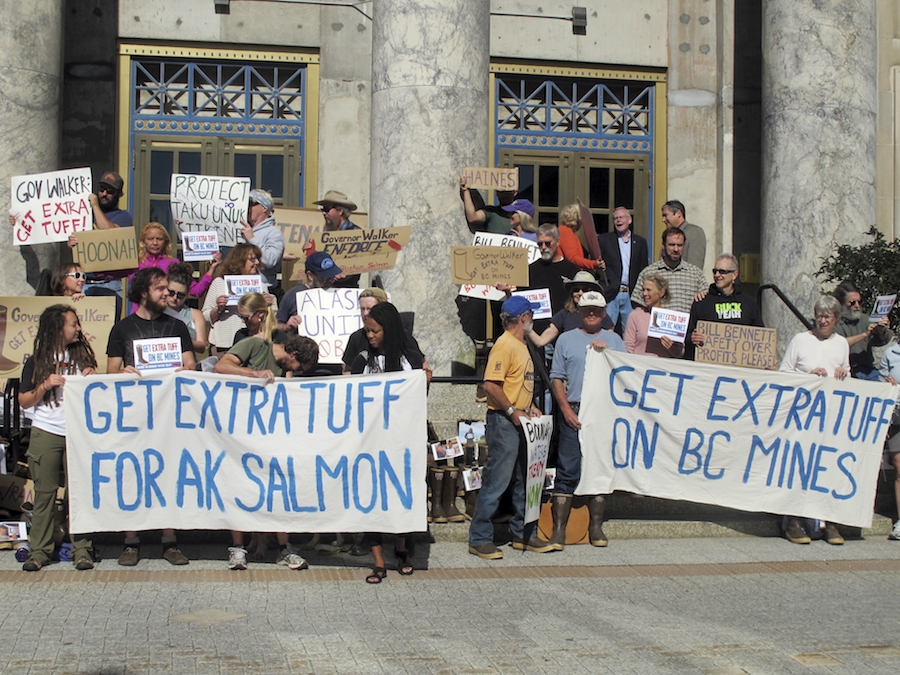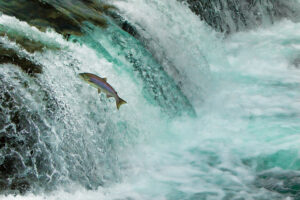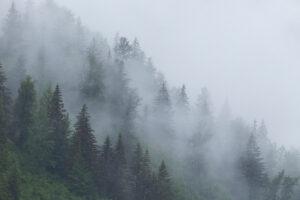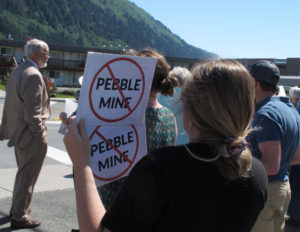How Alaska ‘Gets the Shaft’ From Canada’s Mining Industry
Disasters in British Columbia, where many Canadian mines are located, can have devastating effects downstream. Demonstrators in Alaska air concerns about the potential effects of mine developments in British Columbia. (Becky Bohrer / AP)
Demonstrators in Alaska air concerns about the potential effects of mine developments in British Columbia. (Becky Bohrer / AP)
The border between British Columbia and Alaska is wet.
The boundary is made up mostly of rivers flowing from British Columbia in Canada to southeast Alaska, and what happens in Canada therefore affects southeast Alaska.
Rich mineral deposits, including the gold, silver and copper used in the manufacturing of mobile phones and other products, are buried deep in British Columbia. With the explosion of various technologies that demand these minerals, the “gold rush” is very much alive and growing every day.
According to the Minerals Education Coalition, a baby born in the U.S. in 2018 will use up 539 pounds of zinc, 903 pounds of lead and 985 pounds of copper during his or her lifetime, in phones, gadgets and appliances. In terms of environmental drain, each smartphone made also uses oil to produce plastics and sand to produce glass.
The primary challenge is how to mine and remove these minerals from the earth without destroying the rich, salmon-spawning Alaskan waters and other parts of the environment.
Also at issue is an ongoing battle between Alaska and British Columbia over the rules for building, inspecting and financially indemnifying mines built in British Columbia—because if and when those mines fail, they release tailings that flow into and pollute southeast Alaskan rivers.
Mine tailings are the waterborne chemicals, gravel and silt left after valuable minerals are extracted from ore, and they are extremely toxic.
The history is not good. Contaminated water from extraction processes is stored at the mine, in a structure made up of dams built to function as a holding tank. The primary risk all mines run is a failure of the tailings holding tank; when a tank fails, toxic materials escape into rivers that flow miles downstream, often from British Columbia to the U.S., and primarily to rivers in Alaska and Montana. The number of old mines leaching tailings into salmon-rich rivers is growing.
The most devastating example of a mine failing in British Columbia with disastrous effects downstream in Alaska is that of the Imperial Metals mine at Mount Polley, in the Cariboo region of central British Columbia. The failure began on Aug. 4, 2014, with a rupture and the collapse of the copper and gold mine tailings pond holding tank, releasing years of built-up water and slurry mining waste into Polley Lake. The breach sent more than 847 million cubic feet of mining waste into lakes and rivers nearby, destroying livelihoods and the environment for miles around.
Several problems contributed to the collapse of the Mount Polley mine. The design of the tailings pond had not taken into consideration the unstable bedrock beneath the pond. Over the years, the pressure on that bedrock continued to increase. Furthermore, there were no inspections of that pond while the mine was in operation.
The spill flooded the lake at its outflow point and flowed into the nearby Cariboo River and Quesnel Lake. Four square miles of toxic tailings emptied from the tank. Tests revealed high levels of selenium, arsenic and other metals; these measures fit right in with measures of toxic concentrations at other mining disasters.
A mining failure that is still polluting years later occurred at the Tulsequah Chief mine, on the Tulsequah River. Located 62 miles southwest of Atlin, British Columbia, the mine produced copper, lead, zinc, silver and gold from its opening in 1950 to its failure in 1957. It has been left unattended since then.
According to Jill Weitz, campaign director for Salmon Beyond Borders, the Tulsequah Chief mine has been spewing toxic pollution into the waters ever since, in violation of the Canadian Federal Fisheries Act.
Weitz stated:
This mine is the poster child for [British Columbia’s] under-regulated mining industry. This mine, which is small in comparison to the other dozen projects in various stages of permitting, development, and operation in the transboundary region, has been abandoned since 1957, and [is] slowly leaching acid mine drainage into Southeast Alaska’s largest salmon producing river.
While [British Columbia] taxpayers are on the hook for these abandoned mines, the mining companies make profits, and those of us in Alaska sit below … ticking time bombs.
Border Battles
Successful management of these mines on the boundary rivers is a challenge that affects the environment of both countries.
“Water pollution does not respect international borders. Southeast Alaska communities such as Juneau, Wrangell, Petersburg and Ketchikan are downstream of areas of major mining activity in northwest [British Columbia],” says Chris Zimmer, Alaska campaign director for Rivers Without Borders, an organization that works to protect the rivers straddling the borders between British Columbia and Alaska. He adds:
These communities depend on transboundary rivers, such as the Taku, Stikine and Unuk, for jobs, food, recreation and culture. Harm to water quality and fisheries from upstream mining activities will be felt far more in Alaska than [British Columbia], while the overwhelming majority of economic benefits of the mines will go to [British Columbia]. The saying here is, [British Columbia] gets the mine and Alaska gets the shaft.
The Mount Polley mine failure is considered one of the largest dam mining catastrophes in the past 50 years. According to Earthworks, a nonprofit that follows the effects of mineral and energy developments, it was considered a “loaded gun” because the design of the dam was incorrect. Alaskan mines minister Bill Bennett’s report on Mount Polley stated that the structure collapsed because it was built on a foundation underlain with glacial silt.
More Mines, Opened and Planned
Many people are opposed to new mines in the wake of the Mount Polley spill, including the fishing industry, regional aboriginal peoples, organizations such as Trout Unlimited Alaska, and some politicians. Nonetheless, given both the demand for these metals and the profits to be made from extracting them, explorations are still being conducted for potentially productive mines in British Columbia, including locations at several salmon-producing systems that flow through southeast Alaska.
The large Red Chris gold and copper mine, owned by Imperial Metals, is now operating in the headwaters of the Iskut River, a primary tributary of the Stikine River, whose estuary is near Petersburg and Wrangell, Alaska.
Imperial Metals incorporated in British Columbia in December 1959. Besides the Mount Polley open-pit copper and gold mine, it runs the Red Chris, and it has a 50 percent interest in the Huckleberry open-pit copper mine, and in the Ruddock Creek zinc/lead project.
Alaskan fisheries interests are not comfortable with the status of the company that has a history related to the Mount Polley disaster. Some people are concerned about what could happen if the company were to go bankrupt, and thus lack the funds to manage a failed mine.
Requests to Imperial Metals for comments for this article were not answered.
The KSM mine project, approved by the Canadian government but not yet under construction, is owned by Seabridge Gold Inc. If completed, it will be near the Unuk River system, which supports southeast Alaska’s largest Chinook salmon population and some of the world’s most healthy and vibrant waterways. Its mine tailings ponds could potentially drain into the river, affecting not only local ecosystems, but the environment and economic livelihood downstream in Alaska.
The projected KSM gold and copper mine site is about 20 miles northeast of the Alaskan border, on a major tributary of the Unuk River, which flows into Alaska’s Misty Fjords National Monument in Ketchikan and is a significant river ecosystem for wild salmon. The Unuk River supports all five species of wild Pacific salmon, which are harvested by many stakeholders, including commercial and recreational fishers and indigenous groups.
If built, it would be one of the largest gold projects in the country, and it is projected to have a 52-year mine life. Research and exploration have confirmed the presence of at least 38.2 million ounces of gold, 9.9 billion pounds of copper, 191 million ounces of silver and 213 million pounds of molybdenum at the site.
The KSM Project is expected to employ about 1,800 people on-site annually, and to indirectly create another 4,770 jobs across Canada.
Explorations for another proposed mine, the Pebble Mine, are in progress near the Bristol Bay region of Lake Iliamna and Lake Clark in southwest Alaska. Large deposits of gold, copper and molybdenum have been found in this remote area, near the headwaters of tributaries of both the Nushagak and Kvichak rivers.
This potential site, totally within the U.S., would be under more stringent governmental oversight and financial regulations, yet the fear of pollution exists for this, as for all similar mines.
Some 40 million salmon migrate through Bristol Bay area each year. These are predominantly sockeye, as well as other species of Pacific salmon, which are harvested by commercial and sport fisheries. Those salmon produce billions of offspring that then find their way down into Iliamna, Alaska’s largest lake. They then go out to the Bering Sea, where they eat omega-3-rich krill and get big and fat. After three years, they return to their headwaters to begin the cycle anew. Bristol Bay salmon fishing is a significant aspect of the region’s economy, one that the industry wants to preserve. In 2017, the catch brought in $215 million; in 2018, the haul reached more than $280 million.
In a study by the Alaska Department of Fish and Game, the sockeye salmon run in Bristol Bay in 2018 was nearly 70 percent above the 20-year average. It also was the fourth consecutive year that sockeye runs topped 50 million fish.
Northern Dynasty Minerals, a small Canadian company, began exploratory drilling in the Bristol Bay area in 2002. It holds the mineral rights to 186 square miles of Alaska state land, and it is proposing to build the Pebble Mine.
Northern Dynasty has no experience in mining, so it has reached out for help from Anglo American, Mitsubishi and Rio Tinto. The companies eagerly joined in for a potential share of the estimated $350 billion worth of precious metals buried beneath the ground. Joining forces as the Pebble Limited Partnership, the four companies started planning what could be, at two miles wide and 2,000 feet deep, the largest open-pit mine in North America. As such, it has the highest potential for polluting Bristol Bay due to its size, location and geochemistry, according to the National Resources Defense Council.
Funds to Cover Mining Problems and Failures
The consistent complaint about the British Columbia mining industry is that some of the companies that built open-pit mines are not financially stable enough to run the mines long term, and that they are unable to repair or close down a mine that has failed.
Alaskan organizers who work to change the laws say that the British Columbian government has not addressed these critical concerns from its downstream neighbors, issues that have been raised by every level of Alaska’s government, tribes, municipalities, commercial fishing groups, business owners and tour operators who depend upon clean water and wild salmon rivers.
According to Zimmer, who has been working on transboundary mining issues since 2001, “Alaska requires a full cash bond to cover cleanup and [British Columbia] doesn’t. It’s almost more like ‘when’ than ‘if’ many of these mines go bankrupt and leave Alaska holding the proverbial bag.”
In an op-ed, Zimmer wrote:
How is the province going to get cleanup money from a bankrupt company? Mines in [British Columbia] are chronically under-bonded. So, with a company that can’t pay its bills as a result of bankruptcy or other reason, either nothing happens or taxpayers are stuck with the cleanup bill.
Neither of the two companies that went bankrupt trying to open the Tulsequah Chief, nor Imperial Metals, provided a full cash bond adequate to address cleanup and closure in case of bankruptcy or inability to pay bills.
Needed Governmental Regulations
The current U.S. law that governs mining for gold, silver, copper and other metals on federal lands is the General Mining Law of 1872. There have been no changes since President Ulysses S. Grant signed it 146 years ago. There are no royalties to the taxpayers for these extractions, and, in keeping with the time at which the law was written, there were no provisions for environmental protection.
One result has been many abandoned mines. Earthworks suggests that it will cost taxpayers between $32 billion and $72 billion to clean up these mines, and that taxpayers are potentially liable for billions more in cleanup costs at currently operating mines.
Raúl Grijalva wrote in Sierra, the Sierra Club’s magazine:
Our antiquated mining laws have left us stuck giving away public assets at rock-bottom prices to profitable companies, many of which are foreign-owned, without providing any direct benefit to the taxpayers. Defenders of the 1872 law say we need to keep this broken system going because it creates jobs. But that doesn’t fly—Congress needs to set a higher bar. Federal policy must be about more than shoveling massive subsidies to industries that are, in many ways, already taking advantage of the public.
Robyn Allan is an independent Canadian economist. She has held many executive positions in the private and public sectors, including president and CEO of the Insurance Corporation of British Columbia; vice president of finance for Parklane Ventures Ltd.; and senior economist for British Columbia’s Central Credit Union.
In a statement titled “On Canadian Mines on Transboundary Rivers: The Need for Financial Assurances,” prepared for and presented to a legislative hearing in the Alaska State Legislature, Allan wrote:
Notwithstanding the recently signed Statement of Cooperation between the [British Columbia] and Alaska governments, the State of Alaska cannot rely upon the Province of [British Columbia] to adequately protect downstream interests threatened by upstream mining activities that [have] been, or will be, permitted and ,,, regulated by the [British Columbia] Ministry of Energy and Mines and the [British Columbia] Ministry of Environment.
Allan stated that the Canadian and U.S. governments must work together to investigate the current and long-term effects of mining in British Columbia and develop measures to ensure that downstream resources are not harmed. Allan emphasized that:
A fulsome and effective financial assurance regime is needed in [British Columbia] to protect the environment, guarantee reclamation of mine sites, and in the event unintended major or catastrophic pollution occurs, ensure cleanup, remediation and financial compensation for those affected.
Seabridge Gold maintains it has taken every precaution in planning the KSM Project, including plans to build a holding tank that would capture all toxic tailings from the mining process in a “double sealed” underground holding facility that would not, it maintains, fail.
Nonetheless, Aaron Mintzes, senior policy counsel at Earthworks, states that the fear of mining failures is real.
We are not buying the company (KSM) line. We are unmoved by claims that modern mining is somehow clean. What we have instead is the environmental disaster at Mt. Polley. The failure of a mine the size of KSM would cause damage on the order of magnitude [that would] make the Mt. Polley looks small.
Multiple requests for comment for this article from Seabridge Gold about the KSM mine were not answered.
Congressional Pressure
An Alaska delegation that included Sens. Lisa Murkowski and Dan Sullivan, Rep. Don Young, Gov. Bill Walker and Lt. Gov. Byron Mallott wrote a letter to Secretary of State Mike Pompeo on Oct. 9, urging him to discuss the risks posed by the transboundary mining activity during bilateral meetings between the United States and Canada. The letter outlined Alaska’s priorities for strong and continued engagement between the State Department and the Canadian government on the management of mining activity affecting Alaska and British Columbia’s transboundary waters.
The letter was a follow-up to a request that had been made earlier to then Secretary of State Rex Tillerson, with similar asks. The new letter specifically requests that the State Department deliver this “strong message” to Global Affairs Canada at U.S.-Canada bilateral meetings.
The Canadian Ministry of Energy, Mines and Petroleum Resources recognizes that British Columbia and Alaska share a lot of common interests that transcend borders.
A spokesman from the ministry says that the protection of the shared transboundary waterways is a key concern for people on both sides of the border. In fact, based on the memorandum of understanding signed by British Columbia and Alaska in November 2015, both parties agreed to a statement of cooperation on the protection of transboundary waters.
The ministry indicates that this agreement establishes a bilateral working group, consisting of the commissioners of the Alaska departments of Environmental Conservation and Fish and Game and the British Columbian ministers of Energy, Mines and Petroleum Resources and Environment. This working group on water monitoring is charged with identifying a reliable process for the collection of water data; the ministry believes that this cooperative effort is being implemented as planned.
According to the ministry, the two governments also are working closely on several new mining proposals, and Alaska is very much involved in the assessment and permitting of the proposed mines in the transboundary watershed. Those mines are the Red Chris, BruceJack, Galore Creek, Kitsault, KSM and Schaft Creek. The joint British Columbia/Alaska working group is currently implementing its monitoring program in the transboundary watersheds.
Improvement of Mining Safety
In an attempt to standardize mining code safety rules, the ministry commissioned international engineering, geoscience and environmental consulting firm Klohn Crippen Berger to complete a third-party comparison of mining legislation and guidelines in British Columbia, Montana and Alaska. According to the consultants, the comparison found British Columbia’s requirements for mining to be equal to or more stringent than those in Montana or Alaska.
Canada’s environmental assessment act requires all existing and new mines to meet certain standards if the facility is designed to extract groundwater at a rate of roughly 20 gallons or more per second; modifications to the facility are renewable if they will increase the design rate of extraction by 35 percent.
A Difficult Road
Our appetites for and addiction to technology come at a price. The materials that go into tech manufacturing consist of around 40 percent metals (predominantly copper, gold, platinum, silver and tungsten), 40 percent plastics and 20 percent ceramics and trace materials.
In an article titled “For metals of the smartphone age, no Plan B,” Barbara Reck, a research scientist at the Yale School of Forestry and Environmental Studies, wrote:
We all like our gadgets; we all like our smart phones. But in 20 or 30 years, will we still have access to all the elements necessary to provide the particular functions that make a smart phone so great? Based on our findings, it is unlikely that substitution alone can solve potential supply restrictions for any of the metals on the periodic table.
Issues include limited resources, demands for new exploration, needs for stricter standards for mine construction and requirements for financial backing to repair damages caused by poor construction.
It would appear clear that a response to the overlapping and sometimes conflicting desires for more technical products, limited resources and fishing and other environmental concerns can best be found in updated governmental regulations, in both the U.S. and Canada, that include construction, operational oversight, fiscal indemnification requirements and joint management of these rules.
Your support is crucial...As we navigate an uncertain 2025, with a new administration questioning press freedoms, the risks are clear: our ability to report freely is under threat.
Your tax-deductible donation enables us to dig deeper, delivering fearless investigative reporting and analysis that exposes the reality beneath the headlines — without compromise.
Now is the time to take action. Stand with our courageous journalists. Donate today to protect a free press, uphold democracy and uncover the stories that need to be told.







You need to be a supporter to comment.
There are currently no responses to this article.
Be the first to respond.